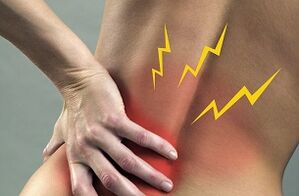
If a person has worked hard, played hard in sports, or walked long distances, at the level of reflex, he puts his hand on his lower back when he stops and relaxes. It is this part of the body that pulls and hurts after exercise, which is explained very simply. The spine is the main support of the skeleton of human bones. It connects all the articular joints and takes most of the stress in any movement. Therefore, it is very natural if, after work or sports, the lower back hurts and hurts.
But not always the causes of back pain in the lumbar region is overwork. Back pain is often a symptom of a serious disorder in the human body; it cannot be ignored, especially if the pain is severe, often recurring. This is a sign that an unknown pathology is already evolving and causing more and more damage to the body every day. It is advisable to consult a doctor as soon as possible: neglected problems with the spine are difficult to treat and can end up in a wheelchair for the patient.
It's interesting:Researchers believe that back pain in the spine is a consequence of human development and, more specifically, bipolar movement. In four-limbed animals, the loads are evenly distributed. A person has to pay for the royal posture and the ability to walk on two legs in violation of the distribution of loads, the curvature of the vertebrae and the back pain.
What can be back pain
Your back can hurt in different ways. Sometimes the pain is intense, unbearable, the patient feels an unbearable burning sensation and a sharp restriction of mobility. Most often, patients complain of lower back pain, pulling, unpleasant sensations that usually appear at night, can wake up in the middle of the night, intensify when the weather changes or after exercise.

Morning stiffness of the spine, back pain "for the weather" and after exercise are the first signs that the joints are out of order.
Back pain is always accompanied by additional symptoms, which you should definitely watch out for and inform your doctor about your observations. According to the accompanying points, it will be easier to determine the true cause of the pain in the lumbar spine. So what symptoms and criteria will have diagnostic value:
- Duration (severity) of pain. It is called acute pain syndrome, which worries for up to three months. If it appears periodically for four months or more, has a different intensity, then it is already referred to as years.
- Localization. Pain in the lower back radiating to the buttocks is commonly called back pain in medicine. If the pain affects the foot, then it is back pain. Also, unpleasant sensations can appear only on the right, left or both sides at the same time.
- The nature of pain. This criterion is fundamental. The pain can be acute and localized at one point, it can be seen in the extremities, buttocks, groin, hypochondrium or lower abdomen. The pain is severe, dull or throbbing. The most difficult thing is to make a correct diagnosis for pain.
- Effects on joint mobility. The doctor will definitely clarify if there is stiffness in the spine, in the limbs, in the hip joints, under what conditions, for how long it lasts.
- Time display. It is also important when and after which the back starts to ache. This happens all the time, in the morning, at night, at night, after exercise, when you turn your head, walk, bend, etc. - the answers to all these questions are extremely important for a correct diagnosis.
In a note:According to doctors' statistics, more than 80% of Europe's population has experienced back pain at least once in their lifetime. More than 25% of medical visits are caused by discomfort and pain in the lumbar region. In addition, 8 in 10 patients are young active, working age 35 to 45 years. Less often, retirees complain of lower back pain, and even less often teenagers.
The reasons
All causes of back pain can be divided into two broad categories:
- normally, they are usually caused by external factors.
- pathological, related to diseases of internal organs.
Physiological reasons include:
- Excessive physical activity when playing sports.
- lifting and carrying weights at work or training;
- hard work at home or in the country;
- hypothermia, prolonged stay in a damp room.

Age combined with physical work are sufficient reasons for back pain.
The pathological causes of back pain, in turn, may be related to diseases of the spine or age-related changes in its structures - this pain syndrome is called primary. If the back pain is caused by malfunctions of other organs, for example, the kidneys, it is called secondary - in this case, it will be necessary to determine the underlying disease with the help of additional special studies and to treat two pathologies at the same time.
Diseases and conditions in which the lower back can be injured:
- Osteochondrosis (spondylosis) - previously diagnosed mainly in the elderly, is now detected at any age.
- Intervertebral hernia - also occurs at any age, if young, then usually after excessive exercise strength
- neuralgia of different nature.
- arthritis and arthropathy, any inflammatory processes in the joints.
- rheumatism and other autoimmune diseases;
- rhizocitis?
- endocrine system dysfunction (diabetes, hyperthyroidism)
- inflammation of the renal pelvis - pyelonephritis.
- inflammation of the urogenital organs.
Back or limb injuries are also painful. To determine the exact cause, you will have to undergo a number of tests, the minimum required is an external examination by a specialist, laboratory urine and blood tests, x-ray, electrocardiogram, ultrasound of the kidneys and urogenital organs. If necessary, additional diagnostic measures will be given.
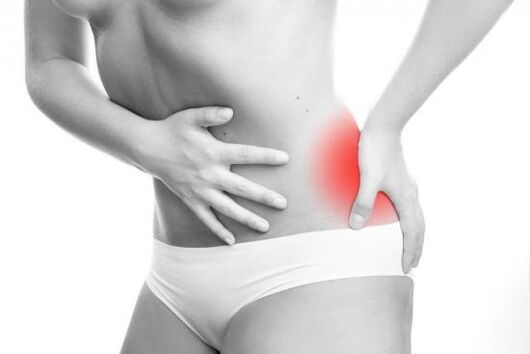
In women, back pain can be caused by cystitis or inflammation of the appendages.
Diseases of the spine as a cause of back pain
If the x-ray shows deformity of the vertebrae, compression and expansion with the formation of bone growth in the form of thorns along the limbs, the doctor diagnoses osteochondrosis or vertebral disease. Until recently, this pathology was considered a disease of retirees and its main cause was named natural changes associated with age in the body, slowing of metabolic processes and wear and tear of the vertebrae.
It has now been shown that osteochondrosis can be caused by a number of other factors in young people and even adolescents. The impetus for degenerative changes in the vertebrae and intervertebral discs is:
- inadequate physical activity with overweight or due to chronic diseases that limit mobility.
- sedentary work
- metabolic disorders during the diet, for example, as a result of which the vertebral structures do not receive enough nutrients and arrive prematurely.
- inappropriate sports - without warming up the muscles and ligaments, without gradually increasing the loads and controlling the lifting of loads.
With osteochondrosis, as it progresses, deformity of the intervertebral discs occurs - they become flat, dense and rough. The affected disc can easily pinch the nerve root, which separates from the spine, causing inflammation. In addition, nerve roots are damaged by bone processes. The patient feels it as intense, sharp pain, along with which there is limited mobility in the lower back. This condition is called sciatica.
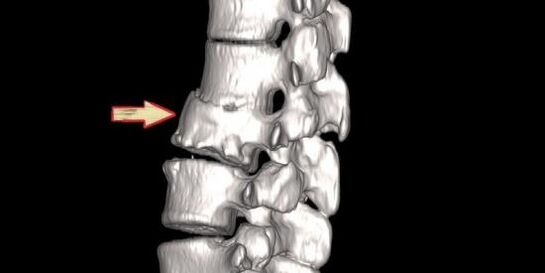
In spondylosis, the growth of bones along the ends of the vertebrae damages the nerve roots and thus causes acute pain syndrome.
Inflammatory processes in the spine can begin to develop as early as adolescence and adolescence. Manifested as recurrent back pain, sometimes annoying at night. They are then combined with morning stiffness, fatigue and reduced physical activity. In advanced stages, the spine is severely deformed, changing a person's posture and gait and forming a lump. Rheumatoid arthritis can develop over the years, in some cases up to ten years. As the course of the disease is slow, the symptoms are often vague, the patient does not go to the doctor, trying to deal with the discomfort with improvised means. For this reason, inflammation of the vertebral joints more often than other pathologies leads to disability.
If the patient during the examination reports discomfort in other joints (shoulder, leg, knee, arm), he complains of pain in the buttocks, reduced visual acuity, stool disorders, vertebral arthritis. A rheumatologist deals with the treatment of such a pathology, his consultation is required immediately, as the pathology develops rapidly and leads to irreversible changes in the bones and joint structures.
Diseases not related to the back as a cause of pain
Sometimes lower back pain causes organ disease that, at first glance, has nothing to do with the spine. Myovascular pain syndrome is a common cause of back pain, which is not accompanied by other symptoms of joint pathology. Usually, young women come to the doctor complaining of back pain after a working day, intense workout in the gym or long stay in one place.
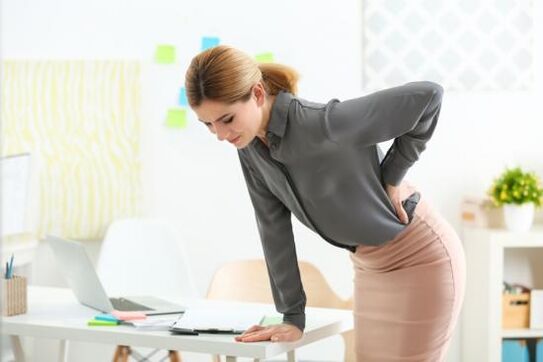
Pain in myofascial syndrome is not associated with damage to the joints of the spine and is easily eliminated with analgesics, massage and NSAIDs.
During the examination, the doctor easily detects spots near the spine when pressure is exerted on which pain occurs. The pain is caused by excessive pressure on the muscle tissues, the nerve roots and the joint elements do not suffer. This condition is not a major threat to the patient's health, but it can significantly reduce the quality of life. For treatment, the doctor prescribes muscle relaxants - drugs that promote muscle relaxation, as well as non-steroidal anti-inflammatory drugs in a short time in minimal doses. It is recommended to adjust the rest and sleep pattern and to monitor physical activity.
Other extra-articular pathologies that may also be accompanied by pain in the spine:
- Cholecystitis and pancreatitis. The pain is located in the right hypochondrium and can be seen on the lower right side of the back.
- Appendicitis. In some cases, severe pain with knives radiates to the lower back, also to the right side. Additional symptoms of inflammation of the appendix: bloating, stool disorders, nausea, vomiting, severe pallor, fever.
- Renal impairment, urolithiasis. Depending on the inflammation of the kidneys, the pain will appear in the right or left lower back. If a stone comes out with urolithiasis, the lower back also hurts a lot, in difficult cases the body temperature may rise.
- Portliness. With excessive body weight, heavy loads are placed on the lumbar spine, which leads to back pain and discomfort.
- Osteomyelitis. Bone infections are accompanied by severe pain and fever.
If no visible damage to the spine or other joints was detected during the examination, no diseases of the internal organs were detected, it makes sense to donate blood for tumor markers and perform an MRI of the spine. Malignant tumors, when they grow, put pressure on the nerve roots and also become causes of pain. Pain syndrome is characteristic of stage 3-4 cancer.
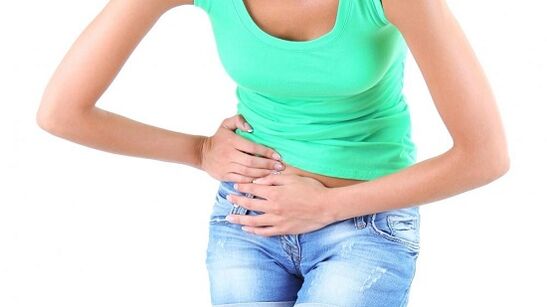
Low back pain can be a symptom of appendicitis.
Because back pain in women
If women have severe back pain in the lumbar region, first of all, you should review your personal diary. Pulling pains can be annoying before menstruation, while it also pulls the lower abdomen, swelling of the mammary glands, the patient is nauseous, some suffer from migraines, food intolerance or, conversely, gluttony.
About the same symptoms are a sign of pregnancy. Therefore, if for several days menstruation has not started and the pain and discomfort persist, it makes sense to take a pregnancy test and make an appointment with a gynecologist.
Also, the cause may be gynecological diseases. Adenitis usually manifests itself by pulling pains in the lower abdomen. But sometimes they radiate to the lower back. Similar sensations occur when the ovarian cysts twist. With the onset of menopause, many women complain of a burning sensation in the lower back, stiffness. In any case, a therapist or rheumatologist will advise you to consult a gynecologist.
Causes of pain in men
In men, back pain mainly due to professional activities - hours of driving, working on a computer, lifting and carrying weights, professional sports.
But pain in the right or left side of the back can also be one of the symptoms of prostatitis or a pathology such as epididymitis. To rule out or confirm pathologies, you should be examined by an andrologist.
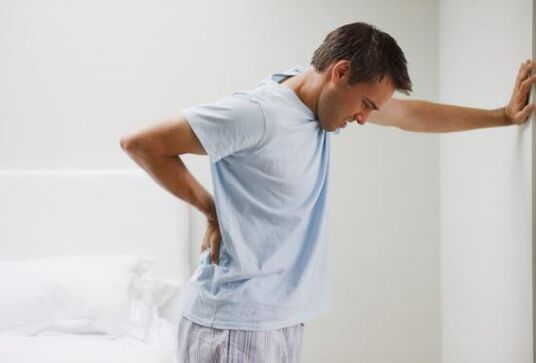
Men with back pain should definitely consult an andrologist to rule out prostatitis.
When and what treatment is required
Even with very severe, persistent back pain, most patients do not think they need serious treatment and expect only one thing from the doctor - a good relief to help immediately and for a long time. Unfortunately, there is no such drug. The pain syndrome can be eradicated with injections and pills, but the effect will not be long-term, as the cause of the discomfort will not be eliminated. Treatment methods will be determined depending on what caused the back pain.
Bruises and muscle stimuli
The first thing you need to do is give your back a complete rest. This means that you can not go into sports, lift weights, stand long, walk, run, jump and cover. It is recommended to get rid of extra pounds, with a sedentary job and inactive lifestyle, instead, you should think about saving sports - for example, yoga, Pilates, swimming. In the future, you will need to rethink your habits and adjust the load on your spine.
What to do before seeing a doctor:
- Take an analgesic or non-steroidal anti-inflammatory drug in a minimal dose.
- fasten the lower back with a makeshift corset - a towel or a scarf.
- to reduce swelling, drink herbal tea with a diuretic effect.
What the doctor will advise:
- short-term non-steroidal anti-inflammatory drugs.
- muscle relaxants to relieve muscle spasm and tension.
- massage and warming of the back (absence of inflammatory processes).
- B vitamins.
If you follow all the recommendations, the pain will disappear completely in 7-14 days.
I remember!If there is an increase in body temperature, pain in the leg or other parts of the body, mobility is limited or other atypical symptoms appear, under no circumstances should you seek the help of a chiropractor, warm up or massage yourself. It is also not recommended to take painkillers, as this will complicate the diagnosis.
Pathology of the spine
Early diseases are treated using the same techniques as bruises or other injuries. In addition, doctors can prescribe chondroprotectors - drugs that protect joint structures from destruction and stimulate their recovery.
For compression fractures of the spine, extensive intervertebral disc herniation, severe osteochondrosis or arthritis, surgery is indicated. Depending on the violation detected, the operation can be simple and is performed under local anesthesia or performed in various stages for six months. After surgery of any complexity, you will need a course of antibiotics, wearing a bandage and physical therapy for complete recovery.
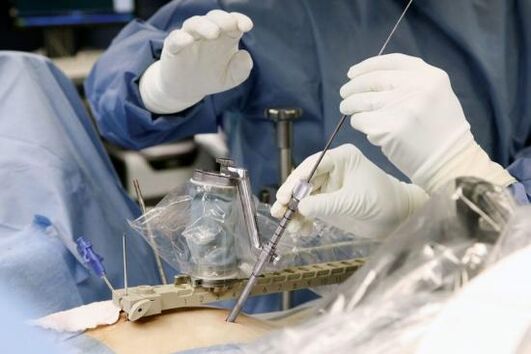
Modern technologies make it possible to perform minimally invasive interventions on the spine with minimal risk of complications.
Today, spine surgeries are no longer excellent, a rich and varied experience has been accumulated, there is special equipment that allows you to solve almost any problem. Therefore, if the condition is difficult and the doctor has recommended surgery, it makes no sense to delay it. The faster it is performed, the more chances you have for complete pain relief and restoration of spinal function.
Auxiliary tips
Timely and effective treatment of back pain is often difficult for an extremely common reason - the patient does not know which doctor to consult. If the pain preceded the injury, then everything is simple - you need to go to an injured person. He will probably prescribe analgesics and a range of non-steroidal anti-inflammatory drugs, and then suggest various physiotherapy procedures - electrophoresis, magnetotherapy, massage and exercise therapy. This is the standard treatment for back injuries.
The difficulty is that when struck or dropped, the nerve endings can be affected. And then you have to involve a neurologist who will suggest his own methods of treatment. A rheumatologist or orthopedist will have his or her own opinion. And if, during the examination, the pathology of any of the internal organs is revealed, for example, the urogenital system, the patient will be completely confused about what should be treated and who should listen. By the way, for this reason many people abandon the methods of formal medicine and turn to non-traditional, ie folk remedies, which eventually lead to worsening of the condition and the development of complications.
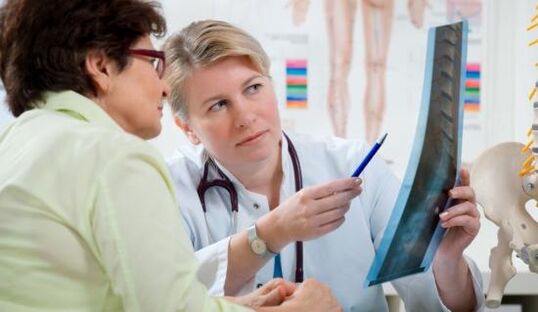
It happens that doctors make a wrong diagnosis and prescribe the wrong treatment, which leads to disease progression and complications.
What to do in such a situation? Do not panic or rush, but go through the prescribed course of treatment to the end, focusing on your own emotions and well-being. If, after two to four weeks, your back hurts just as badly and there is not the slightest improvement, it makes sense to contact another doctor and have a second examination to review the correctness of the diagnosis. Changing one analgesic to another instead of electrophoresis makes no sense to do UHF.
As for the treatment of the back with homeopathic medicines at home, here, too, we should not be seduced and recklessly believe the promises of traditional healers. A suitable adult should understand: traditional methods of treatment are good in the recession stage, when the condition is stable or to prevent relapses and complications. Rheumatoid arthritis, for example, as an autoimmune disease, herbal tinctures can not be cured in any way.

Herbs will help improve overall body tone, but are unlikely to help with hernias, disc herniation or compression fractures.
The right decision would be if your lower back hurts constantly and doctor appointments at the regional clinic are ineffective - go to a reputable private clinic and get tested there. It is not free, but you will learn the real reason and you will be able to start the right treatment and not experiment with folk remedies and standard analgesics that do not give any therapeutic effect.
Summary:Almost all adults experience back pain at least once in their lifetime. In fact, there can be many reasons: from overwork to severe pathology of the spine, kidneys, infections or metabolic disorders in the body. It is important to determine the cause accurately and correctly and to start the appropriate treatment as early as possible. The spine is the main joint in the human skeleton, its dysfunction and destruction in the absence of adequate medical care will inevitably lead to loss of mobility and disability.

































